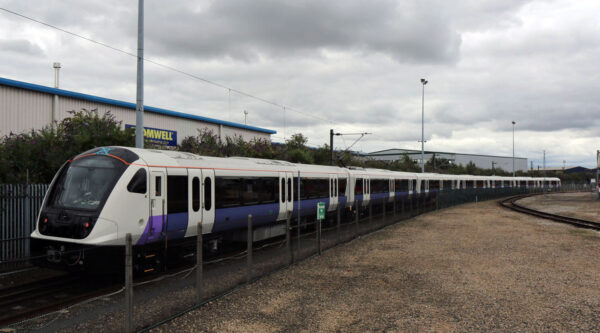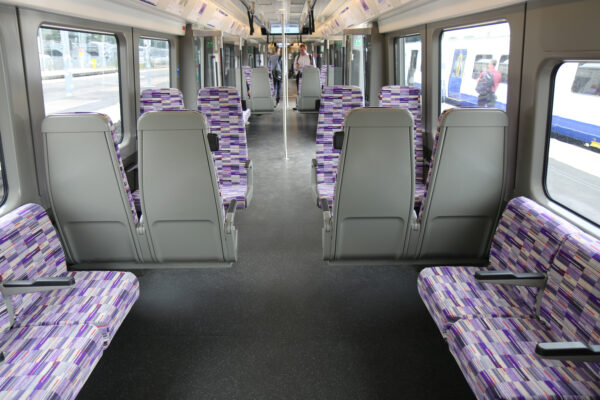Elizabeth line trains are long. Very long. So long that they don’t fit into some of the stations they call at and they have to use what’s known as selective door opening.
The Elizabeth line railway is made up of a mix of the brand new stations in the centre of London, and outside London it runs along existing railways and stations that have been upgraded to accept Elizabeth line trains. However, while the older refurbished stations gained step-free access for the first time with new lifts, staircases and often new ticket halls, it wasn’t generally possible to lengthen all the platforms as well. So the backs of the trains hang over the edge of the station.
When the trains call at the shorter stations, announcements are played to warn people that the rear doors won’t open at the station, and because you can walk through the full length of the trains, there’s no problem with people at the back walking to the next car along to get to a working door.
This is not unique to the Elizabeth line.
London’s surging population over the past 40 years has often seen trains lengthened to cope with passenger demand, and beyond the limits that were built into the station design. So you can have London Overground trains that are too long for the Victorian era East London Line tunnels, DLR trains that are longer than the platforms at Cutty Sark, and some tube stations where the last door won’t open as they are just a bit too long for the station.
The existing fleet of London Underground trains vary a lot in length but averages at 115 metres long. However, the Elizabeth line trains are over 200 metres long. Much longer than a tube train. And unsurprisingly, they carry a lot more passengers — up to 1,500 passengers per train on the Elizabeth line compared to an average of 921 passengers in a tube train.
So, the Elizabeth line will, when outside central London occasionally need to call at stations that are shorter than the long trains it uses.
According to a TfL FOI response, the stations where doors won’t open are:
- Seven Kings – rear 3 doors (i.e. the rear car)
- Manor Park – rear 6 doors (i.e. the rear 2 cars)
- Forrest Gate – rear 4 doors (i.e. the rear car + 1 door)
- Maryland – rear 5 doors (i.e. the rear car + 2 doors)
- Paddington Main Line – the centre door on each of the rear 6 cars due to platform curvature
- Hanwell – rear 8 doors (i.e. the rear 2 cars + 2 doors)
- Hayes & Harlington – 1 rear door (i.e. the last door in rear car)
- Iver – rear 4 doors (i.e. the rear car + 1 door)
- Langley – rear 5 doors (i.e. the rear car + 2 doors)
- Burnham – rear 3 doors (i.e. the rear car)
- Taplow – rear 3 doors (i.e. the rear car)
- Twyford – rear 4 doors (i.e. the rear car + 1 door)
As an aside, when TfL Rail launched a few years ago running Elizabeth line trains along the mainline railway, they started with 7-car trains that fitted into stations without any problems, but they are now almost entirely upgraded to 9-car trains ready to become the Elizabeth line.
However, while it seems sensible that the central core stations that are all brand new for the Elizabeth line would be built to the correct size for 9-car trains, in fact, the new stations are longer than they need to be.
That’s because they’ve been future-proofed for an upgrade in years to come to allow even longer Elizabeth line trains. The current fleet of 9-car trains have the ability to be lengthened to 10-cars, so in case that ever happens, all the new stations were built with that capacity in mind. After all, it’s an awful lot easier and cheaper to build a tunnel that’s too long when it first opens than it is to try to lengthen it at a later date.
So modern railways are future-proofed in a way that the older railways often couldn’t be.









This also allows for the different blue blob types on parts of the lines. Some are step-free from train-to-street and some from street-to-platform.
https://ukfree.tv/styles/images/2018/Elizabeth-timings.png
When the Tyne and Wear Metro was built every platform had space for three car trains, one more than it started with (and still has). The only limiting factor is the storage of trains, maybe the depot will become double-decker one day!
Just let them run 24 hours and this eliminates the need to build massive new storage depots. Too sensible? Probably
I think the future-proofing allows 11 car trains rather than 10? Certainly the 240m+ platform length in the central core suggests this would be possible. Admittedly I’ve only read this on other independent sites rather than the official Crossrail one.
I’m sure I’d read 11 as well. Which is about the same length as most 12 car trains, because 345 carriages are a bit longer than average.
This has been known since they delivered the first class 345 that Maryland for example can not have it’s platform a extended as its “boxed in” by 2 Road overbridges
And your problem is what exactly? The Elizabeth line is not the only line which cannot accommodate the full length of the trains at all stations that they serve.
I don’t have a problem – I just think it’s interesting.
So one day the Elizabeth Line might go to 10 or even 11 cars and the central stations will be fine, the stations on the main lines can use SDO, but Heathrow is a problem. Not only are the platforms too short there, but they’d be very difficult to extend due to being underground, and I believe there’s issues with longer trains potentially fouling crossover junctions as well. Not ideal.
I wonder, do the 345s only play the SDO announcement in the affected portion of the train? I find it quite annoying on the Overground going from Rotherhithe to Shadwell and having SDO announcements at every single station even though I’m in an area that isn’t affected by it!
The restriction on centre doors at ‘Paddington Main Line’ is interesting. I don’t think I’ve ever seen SDO used in this way before.
I’m assuming that in this context ‘Main Line’ means the ‘upstairs’ platforms rather than the new low level ones. Not exactly surprising, as these are probably the first three door trains on the line out to Reading. In fact it is only surprising that more stations are not affected in this way.